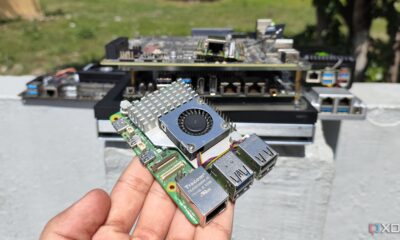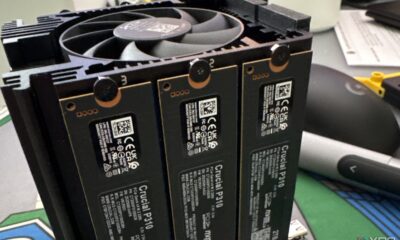Technology
Upgrade Your Raspberry Pi 5: 5 USB Accessories for Better Performance

The Raspberry Pi 5 serves as an effective home server, and its capabilities can be significantly enhanced with specific USB accessories. By integrating these upgrades, users can extend the board’s functionality, improve reliability, and adapt their setups as needs evolve. This article explores five USB enhancements that transform the Raspberry Pi 5 into a more robust and efficient home server.
Enhancing Speed with a USB SSD
One of the most straightforward methods to boost the Raspberry Pi 5’s performance is by adding a USB SSD. The board’s USB 3 ports support modern SATA and NVMe drives, enabling faster data transfers compared to traditional microSD cards. Moving databases, media libraries, and temporary files to solid-state storage noticeably improves system boot times and application responsiveness.
Users migrating their root filesystem to an SSD can maintain their existing installation, as most Raspberry Pi operating systems facilitate this process. By enhancing data reliability, the SSD outperforms microSD cards, which often wear out more rapidly under workloads involving numerous small writes. For those utilizing services like Plex, Jellyfin, or Nextcloud, this upgrade leads to a smoother experience overall.
Improving Connectivity with a USB Network Adapter
While the Raspberry Pi 5 features a gigabit Ethernet port, adding a USB network adapter can offer significant benefits. This accessory allows users to dedicate specific interfaces for tasks like isolating Internet of Things (IoT) devices or managing network segments for testing. By utilizing a second interface, users can reduce congestion when running multiple services simultaneously, ensuring better organization and traffic separation.
Many USB 3 network adapters deliver gigabit performance that matches the onboard port. For instance, one interface can handle regular home usage, while the other manages backup traffic or camera feeds. This setup not only improves performance during heavy workloads but also provides a safeguard: if one connection fails, the other ensures continued access to the server.
Maintaining Performance with USB-Powered Cooling
Cooling solutions represent another effective way to enhance the Raspberry Pi 5’s long-term performance. The device can generate substantial heat during tasks like transcoding and database queries. Incorporating a USB-powered fan or cooling pad can help regulate temperatures, leading to fewer throttling events and consistent performance.
These cooling accessories are typically quiet and easy to position, allowing users to plug them directly into the Raspberry Pi or a nearby hub. By ensuring proper airflow, the Pi remains stable and capable of handling demanding tasks, particularly in warmer environments. This practical upgrade may not be glamorous, but its impact on performance is significant and essential for sustained operation.
Expanding Capabilities with a USB Hub
Given the limited number of ports on the Raspberry Pi 5, a quality USB hub can significantly enhance its flexibility. As users expand their home server setups, powered hubs ensure that each device receives adequate power without overloading the Pi’s power budget. This upgrade mitigates stability issues commonly faced when connecting multiple peripherals.
By utilizing a powered hub, users can avoid random disconnections and power fluctuations, which are particularly concerning when incorporating higher-draw devices such as SSDs or USB tuners. Additionally, a hub simplifies cable management, allowing all devices to connect to a single location. This organization facilitates future upgrades or relocations of the Raspberry Pi without disrupting the overall setup.
Boosting Smart Home Functionality with USB Radios
For smart home servers, dedicated USB radios like Zigbee, Thread, or Z-Wave can significantly enhance communication with sensors and switches. While the Raspberry Pi 5’s built-in wireless capabilities suffice for Wi-Fi, USB radios provide superior performance for low-power networks. By using a high-quality Zigbee coordinator or multiprotocol radio, users can improve reliability and coverage throughout their homes.
These USB radios often include extension cables, allowing users to strategically position antennas away from potential interference caused by the Raspberry Pi itself. As a result, devices connect more reliably, and automations respond faster. For users running platforms like Home Assistant, this upgrade can drastically reduce troubleshooting time and enhance overall efficiency.
In conclusion, incorporating targeted USB accessories can significantly enhance the functionality and performance of a Raspberry Pi 5 as a home server. Each upgrade contributes to improved reliability, speed, and flexibility, making the Raspberry Pi feel more akin to a full-fledged server while remaining cost-effective and manageable. These enhancements not only support seamless operation but also help users create a more dependable home lab or smart home environment.
-

 Technology5 months ago
Technology5 months agoDiscover the Top 10 Calorie Counting Apps of 2025
-

 Health3 months ago
Health3 months agoBella Hadid Shares Health Update After Treatment for Lyme Disease
-

 Health3 months ago
Health3 months agoErin Bates Shares Recovery Update Following Sepsis Complications
-

 Technology4 months ago
Technology4 months agoDiscover How to Reverse Image Search Using ChatGPT Effortlessly
-

 Technology1 month ago
Technology1 month agoDiscover 2025’s Top GPUs for Exceptional 4K Gaming Performance
-

 Technology3 months ago
Technology3 months agoElectric Moto Influencer Surronster Arrested in Tijuana
-

 Technology5 months ago
Technology5 months agoMeta Initiates $60B AI Data Center Expansion, Starting in Ohio
-

 Technology5 months ago
Technology5 months agoRecovering a Suspended TikTok Account: A Step-by-Step Guide
-

 Health4 months ago
Health4 months agoTested: Rab Firewall Mountain Jacket Survives Harsh Conditions
-

 Lifestyle5 months ago
Lifestyle5 months agoBelton Family Reunites After Daughter Survives Hill Country Floods
-

 Health3 months ago
Health3 months agoAnalysts Project Stronger Growth for Apple’s iPhone 17 Lineup
-

 Technology4 months ago
Technology4 months agoHarmonic Launches AI Chatbot App to Transform Mathematical Reasoning





















